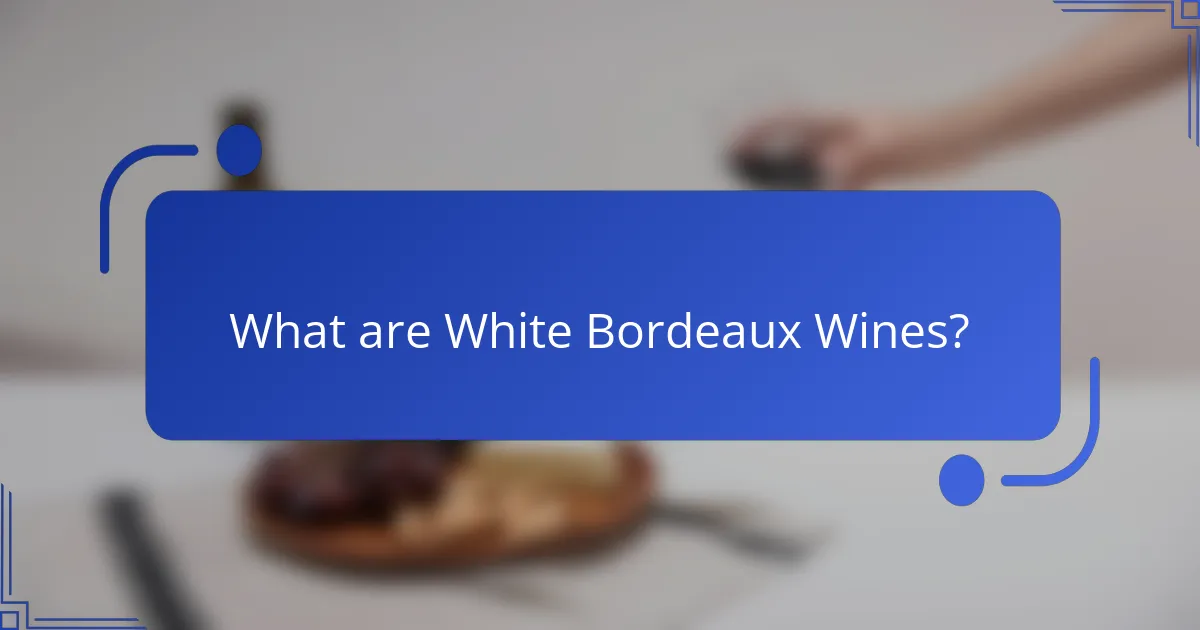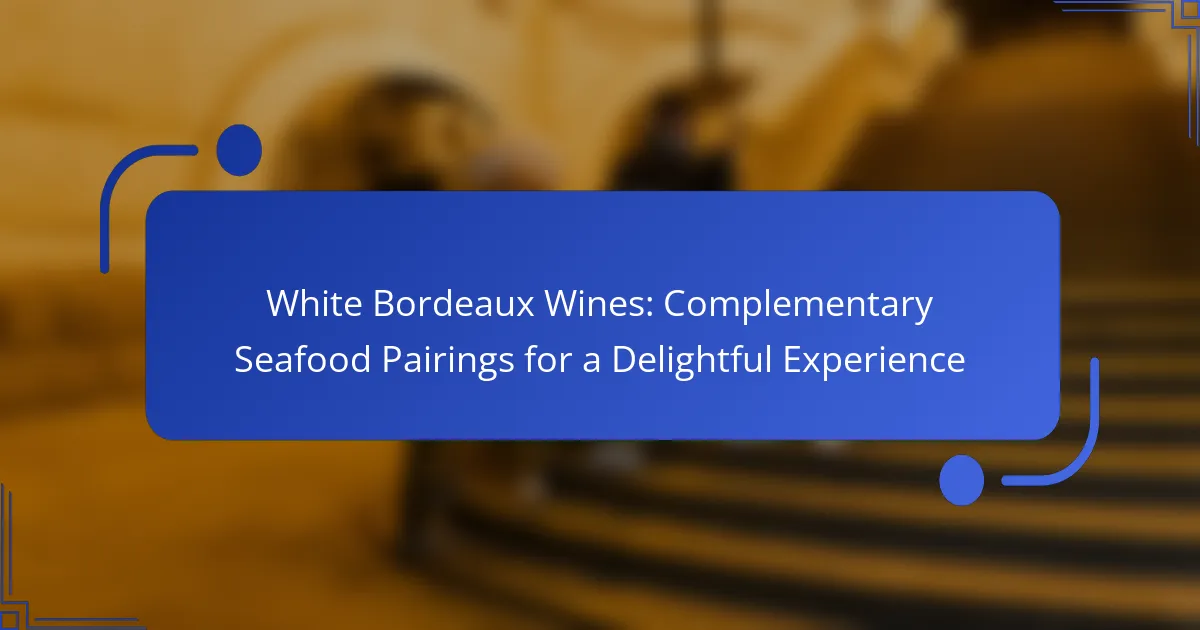
What are White Bordeaux Wines?
White Bordeaux wines are white wines produced in the Bordeaux region of France. They primarily consist of Sauvignon Blanc, Sémillon, and Muscadelle grapes. These wines are known for their crisp acidity and aromatic complexity. White Bordeaux can range from dry to sweet, with the dry varieties being more common. The region’s climate and terroir contribute to the wine’s distinctive character. Notable examples include the dry wines from Pessac-Léognan and the sweet wines from Sauternes. White Bordeaux wines are often paired with seafood due to their refreshing qualities and flavor profiles.
How are White Bordeaux Wines produced?
White Bordeaux wines are produced primarily from Sauvignon Blanc, Sémillon, and Muscadelle grapes. The production process begins with harvesting the grapes, usually done by hand to ensure quality. After harvesting, the grapes are gently pressed to extract the juice. The juice is then fermented in stainless steel tanks or oak barrels. Fermentation typically lasts from two to four weeks. After fermentation, the wine may undergo malolactic fermentation to soften acidity. The wine is then aged on its lees for added complexity. Finally, the wine is filtered and bottled for sale. This method enhances the wine’s flavors and aromas, making it a preferred choice for pairing with seafood.
What grape varieties are commonly used in White Bordeaux Wines?
The grape varieties commonly used in White Bordeaux wines are Sauvignon Blanc, Sémillon, and Muscadelle. Sauvignon Blanc is known for its crisp acidity and aromatic profile. It contributes citrus and herbal notes to the wine. Sémillon adds richness and body, often providing flavors of stone fruit and honey. Muscadelle is less common but contributes floral aromas and a hint of sweetness. These varieties are blended to create the distinctive character of White Bordeaux wines. The combination of these grapes allows for a range of styles, from dry to sweet.
What is the typical aging process for White Bordeaux Wines?
White Bordeaux wines typically undergo an aging process that lasts from three to ten years. This aging allows the wines to develop complexity and integrate flavors. The process often occurs in oak barrels, which can impart additional characteristics such as vanilla and toast. Temperature control and humidity are crucial during aging to prevent spoilage. The wines may also undergo malolactic fermentation, softening acidity and enhancing creaminess. Over time, the color may shift from pale yellow to a deeper gold. This evolution in flavor and aroma makes aged White Bordeaux wines highly sought after. The best examples can age even longer, offering unique tasting experiences.
What are the unique characteristics of White Bordeaux Wines?
White Bordeaux wines are primarily characterized by their blend of Sauvignon Blanc, Sémillon, and Muscadelle grapes. These wines typically exhibit a vibrant acidity and a range of flavors, including citrus, stone fruit, and floral notes. The aging process often involves oak barrels, which can impart additional complexity and richness. The unique terroir of the Bordeaux region contributes to the wine’s minerality and depth. White Bordeaux wines are known for their versatility, making them excellent pairings with seafood dishes. The balance of acidity and fruitiness enhances the flavors of dishes like grilled fish and shellfish. These wines often have a medium to full body, with some examples showing a creamy texture from malolactic fermentation.
How do the flavors and aromas of White Bordeaux Wines vary?
The flavors and aromas of White Bordeaux wines vary significantly based on grape composition and terroir. Typically, these wines are blends of Sauvignon Blanc, Sémillon, and Muscadelle. Sauvignon Blanc contributes citrus and herbal notes, while Sémillon adds richness and honeyed flavors. The terroir influences the wine’s mineral characteristics and aromatic profile.
For example, wines from cooler regions exhibit more pronounced acidity and fresh fruit aromas. In contrast, those from warmer areas may present riper fruit flavors and floral notes. Aging in oak barrels can introduce vanilla and spice aromas, further diversifying the flavor profile.
Overall, the combination of grape varieties and environmental factors results in a complex range of flavors and aromas in White Bordeaux wines.
What is the significance of terroir in White Bordeaux Wines?
Terroir is significant in White Bordeaux Wines because it influences the wine’s flavor, aroma, and overall character. The unique combination of soil, climate, and topography in the Bordeaux region shapes the grapes’ growth. These factors result in distinct taste profiles that reflect the specific vineyard’s conditions. For instance, the gravelly soils in Graves contribute to the minerality in Sauvignon Blanc. Similarly, the maritime climate provides a balance of acidity and ripeness. Terroir also impacts the aging potential of the wines. Wines from specific terroirs can age differently, enhancing their complexity over time. Hence, terroir is essential for understanding the quality and diversity of White Bordeaux Wines.

Why pair White Bordeaux Wines with seafood?
White Bordeaux wines are ideal for pairing with seafood due to their crisp acidity and refreshing flavors. The high acidity in these wines enhances the natural flavors of various seafood dishes. This characteristic helps to cut through the richness of dishes like creamy sauces or buttery preparations. Additionally, the fruit-forward notes in White Bordeaux complement the delicate flavors of fish and shellfish. Studies show that acidity in wine enhances the perception of freshness in seafood. This pairing tradition is supported by culinary experts who recommend White Bordeaux for dishes like oysters, scallops, and grilled fish. The harmonious balance between the wine and seafood elevates the overall dining experience.
What makes seafood a suitable match for White Bordeaux Wines?
Seafood is a suitable match for White Bordeaux wines due to their complementary flavor profiles. White Bordeaux wines are typically crisp and acidic. This acidity enhances the natural flavors of seafood. The minerality in these wines also mirrors the oceanic qualities of seafood. Additionally, the fruitiness of White Bordeaux can balance the saltiness of various seafood dishes. Pairing studies show that white wines enhance the perception of freshness in seafood. The aromatic characteristics of these wines can elevate the overall dining experience. This combination creates a harmonious balance that is widely appreciated.
How do the acidity and flavor profiles of White Bordeaux Wines complement seafood?
White Bordeaux Wines have high acidity and diverse flavor profiles that enhance seafood dishes. The acidity in these wines balances the richness of seafood, making each bite taste fresher. It helps cut through the fat in oily fish like salmon or mackerel. The crispness of the wine complements lighter seafood options such as shellfish and white fish. Flavor notes in White Bordeaux, including citrus and green apple, elevate the taste of seafood. These flavors pair well with the natural sweetness found in many seafood varieties. Studies show that acidity in wine enhances the overall dining experience by refreshing the palate. This synergy between the wine and seafood creates a harmonious pairing that is widely appreciated.
What types of seafood are traditionally paired with White Bordeaux Wines?
White Bordeaux wines are traditionally paired with a variety of seafood. Common pairings include oysters, scallops, and grilled fish. These wines complement the delicate flavors of these seafood types. Additionally, shrimp and crab are also popular choices. The acidity in White Bordeaux enhances the taste of these dishes. This pairing tradition is rooted in the coastal regions of Bordeaux. The local cuisine often features fresh seafood, making these wines a natural match.
What are some recommended pairings of White Bordeaux Wines and seafood?
White Bordeaux wines pair excellently with various seafood dishes. Oysters and White Bordeaux create a classic match. The wine’s acidity complements the brininess of the oysters. Grilled fish, such as sea bass, also pairs well. The wine enhances the flavors without overpowering them. Shellfish like shrimp and scallops are great choices too. The crispness of White Bordeaux balances the richness of these dishes. Furthermore, dishes with lemon butter sauce work harmoniously with the wine’s citrus notes. These pairings are supported by the wine’s balanced acidity and fruit-forward profile.
What specific White Bordeaux Wines pair well with shellfish?
Specific White Bordeaux wines that pair well with shellfish include Château Carbonnieux, Château Smith Haut Lafitte, and Château de Fieuzal. These wines are known for their crisp acidity and citrus notes. The vibrant flavors enhance the delicate taste of shellfish. For instance, Château Carbonnieux offers a blend of Sauvignon Blanc and Sémillon. This combination complements the sweetness of shellfish effectively. Similarly, Château Smith Haut Lafitte provides a rich texture that pairs beautifully with oysters and shrimp. These selections are favored by sommeliers for their compatibility with various shellfish dishes.
How do White Bordeaux Wines enhance the flavors of grilled fish?
White Bordeaux wines enhance the flavors of grilled fish through their acidity and aromatic profile. The high acidity in these wines balances the richness of grilled fish. This interaction highlights the fish’s natural flavors without overpowering them. Additionally, the citrus and floral notes in White Bordeaux complement the smoky char from grilling. Specific grape varieties like Sauvignon Blanc and Sémillon contribute to this aromatic complexity. Studies show that wines with bright acidity can elevate seafood dishes significantly. The freshness of White Bordeaux makes it an ideal pairing for various grilled fish types.

How can you enhance your experience with White Bordeaux Wines and seafood?
To enhance your experience with White Bordeaux wines and seafood, focus on pairing specific seafood types with the wine’s characteristics. White Bordeaux, known for its crisp acidity and fruity notes, complements shellfish like oysters and shrimp. The wine’s citrus flavors elevate the brininess of oysters. Pairing with grilled fish, such as sea bass, highlights the wine’s herbal undertones.
Serving the wine chilled enhances its refreshing qualities. Consider using a proper glass to concentrate the aromas. Additionally, incorporating light sauces or herbs can further enhance the synergy between the wine and seafood.
Experts suggest that the ideal serving temperature for White Bordeaux is between 45 to 50 degrees Fahrenheit. This temperature allows the wine’s flavors to shine without overpowering the seafood.
What tips can improve your pairing experience?
To improve your pairing experience with White Bordeaux wines and seafood, focus on matching flavors and textures. Select seafood that complements the wine’s acidity, such as shellfish or white fish. Consider the preparation method; grilled or roasted seafood enhances the wine’s profile. Pay attention to the wine’s age; older wines may pair better with richer dishes. Serve the wine at the right temperature, ideally chilled, to enhance its refreshing qualities. Experiment with different pairings to discover personal preferences, as taste can vary widely.
How should White Bordeaux Wines be served for optimal enjoyment?
White Bordeaux wines should be served chilled for optimal enjoyment. The ideal serving temperature is between 45°F to 50°F (7°C to 10°C). This temperature range enhances the wine’s refreshing acidity and aromatic complexity. Serving at the correct temperature allows the flavors to be more pronounced. Additionally, using a white wine glass helps concentrate the aromas. Pouring a small amount allows for better aeration. Pairing White Bordeaux with seafood enhances the tasting experience. The crispness of the wine complements the delicate flavors of fish and shellfish.
What are common mistakes to avoid when pairing White Bordeaux Wines with seafood?
Common mistakes to avoid when pairing White Bordeaux wines with seafood include selecting overly rich wines for delicate dishes. White Bordeaux is typically crisp and refreshing. Pairing it with heavy sauces can overwhelm the wine’s flavors. Another mistake is ignoring the wine’s acidity. Seafood often benefits from a wine that can balance its natural saltiness. Additionally, serving the wine too warm can diminish its refreshing qualities. Lastly, not considering the preparation method of the seafood can lead to mismatches. For example, grilled seafood pairs differently than steamed or fried.
White Bordeaux wines are a distinctive category of white wines from the Bordeaux region of France, primarily made from Sauvignon Blanc, Sémillon, and Muscadelle grapes. Known for their crisp acidity and aromatic complexity, these wines can range from dry to sweet and are often paired with seafood due to their refreshing qualities. The article explores the production process, grape varieties, aging techniques, and the significance of terroir in shaping the unique characteristics of White Bordeaux wines. Additionally, it provides insights on optimal seafood pairings, serving tips, and common mistakes to avoid for an enhanced dining experience.
